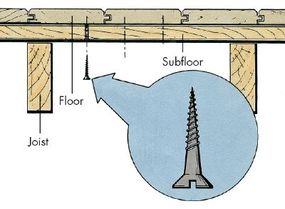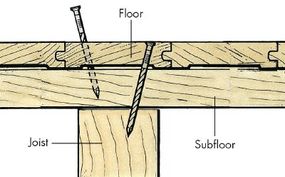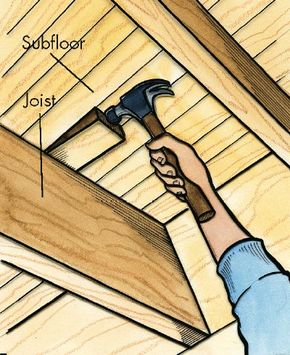When you consider the punishment caused by everyday foot traffic, it's surprising that floors and stairs hold up as well as they do. Eventually, though, wear and tear take their toll. Squeaks develop, minor damage afflicts resilient tile and sheet flooring, burns dot your carpeting, or the entire surface begins to show its age and needs replacing or refinishing. Fortunately, repairs are much simpler than you might have thought. In this article, you will find solutions for solving all of these common floor problems.
Let's begin with how to get squeaks out of your floors. Squeaky floors aren't serious structural problems, but they can be annoying. If you have exposed hardwood floors, you may be able to stop the squeak by sprinkling talcum powder over the noisy boards and sweeping it back and forth to force it down into the cracks.
Advertisement
If there's a basement or crawl space under the noisy floor, work from this area to locate the problem. You'll need a helper upstairs to walk on the squeaky spot while you work. Watch the subfloor under the noisy floorboards while your helper steps on the floor above. If the subfloor moves visibly or if you can pinpoint the noise, outline the affected areas with chalk. At the joists closest to your outlines, look for gaps between the joist and the subfloor; wherever there's a gap, the floorboards can move. To stop squeaks here, install shingles or wood shims into the gaps to reduce movement.
If there are no gaps along the joists, or if the squeaks are coming from an area between joists, there's probably a gap between the floorboards and the subfloor. To pull the two layers together, install wood screws up through the subflooring in the squeaky areas. Make sure you drill pilot holes before inserting the screws so you don't crack the wood. The wood screws must be long enough to penetrate into the floor above you but not so long that they go all the way through the boards and stick up through your floor.

If you can't get at the floor from underneath, you'll have to work from the top with spiral flooring nails. First, locate the squeak and try to determine whether it's at a joist or between joists. To eliminate the squeak, drive two spiral flooring nails, angled toward each other in a V, through the floorboards and the subfloor. If the squeak is at a joist, use longer spiral flooring nails, driving them through the floorboards and the subfloor and into the joist. Drill pilot holes first to keep the boards from splitting.

If the floor is tiled or carpeted and you can't get at the floorboards from above or below, you probably won't be able to eliminate the squeak without removing the floor covering. Before you do this, try to reset the loose floorboards by pounding. Using a hammer and a block of scrap wood as a buffer, pound the floor firmly in an area about 2 or 3 feet square over the squeaky floorboards. The pressure of the pounding may force loose nails back into place.
In the next section, we'll look at how to repair damaged tile floors.
